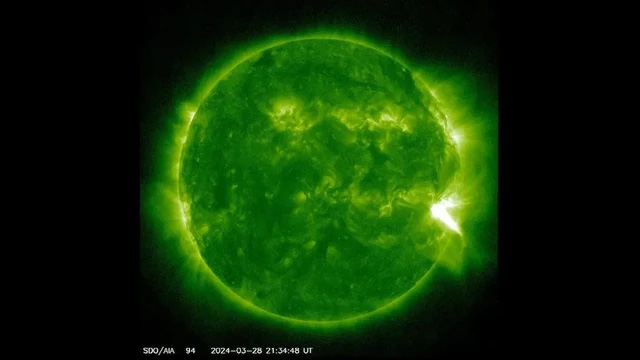NASA spacecraft reveals the cause of radio signal loss in the Pacific Ocean
A very powerful explosion ionized the upper part of the Earth's atmosphere, leading to disruption of shortwave radio signals .
According to Live Science, the US Oceanic and Atmospheric Administration (NOAA) has just provided an answer for the radio wave disruption incident that recently occurred in the Pacific Ocean.
It is a "fire bomb" fired by the Sun since March 28. After a few days of travel, powerful electromagnetic radiation from this "fire bomb" hit the Earth's magnetosphere, causing problems with the radio communication system.

The moment the solar flare flared up, the root cause of the radio wave loss - (Photo: SDO/NASA).
This conclusion was reached thanks to images from the Solar Dynamics Observatory (SDO), a NASA spacecraft circling our parent star.
In the photo, a very strong spot of light flashes from the surface of the Sun. That was the moment the "fire bomb" was fired.
It was a flare of magnitude X1.1 , one of the most powerful ever to burst from the Sun. The time it started emitting from the Sun was 4:56 p.m. March 28 (US time), corresponding to 4:56 a.m. March 29 Vietnamese time.
Taking into account the time it took for this firebomb to reach Earth, the loss of radio waves in the Pacific was entirely appropriate.
This flare was also accompanied by a coronal mass ejection (CME), which can be understood as a large fireball made of plasma.
NOAA predicted it would miss Earth, but what happened next showed that whether it missed or not, the fireball and its accompanying flare clearly caused a powerful geomagnetic storm.
Earth is likely to be hit even harder in the coming days, as the Sun enters the peak of its 11-year cycle.
However, it is still a natural phenomenon. It is also difficult for humans to directly feel the impact of geomagnetic storms, but aerospace operators may need to monitor space weather more closely, because it also has some influence on navigation systems. , television.
- NASA connected with the spacecraft that had lost its signal two years ago
- NASA received a communication signal from a spacecraft 24 billion kilometers away
- Discovered a huge gold store at the bottom of the Pacific Ocean
- Russian spacecraft 'has just fallen into the Pacific Ocean'
- Discover radio history and radio technology
- The billion-dollar spacecraft communicating with NASA from the dead
- Cosmic signals repeat on a 157-day cycle
- The US satellite has plunged into the Pacific Ocean
- Why don't planes often fly across the Pacific Ocean?
- Mysterious radio waves can be a sign of aliens
- Who invented radio?
- Signal detection of 5 billion years old, preceding the solar system
 Van Allen's belt and evidence that the Apollo 11 mission to the Moon was myth
Van Allen's belt and evidence that the Apollo 11 mission to the Moon was myth The levels of civilization in the universe (Kardashev scale)
The levels of civilization in the universe (Kardashev scale) Today Mars, the sun and the Earth are aligned
Today Mars, the sun and the Earth are aligned The Amazon owner announced a secret plan to build a space base for thousands of people
The Amazon owner announced a secret plan to build a space base for thousands of people Amazing discovery of 4.5 billion year old alien ocean of life
Amazing discovery of 4.5 billion year old alien ocean of life  What would happen if you dug a hole through the Earth and jumped in?
What would happen if you dug a hole through the Earth and jumped in?  Chilling discovery of cosmic object that almost brought the Earth to 'apocalypse'
Chilling discovery of cosmic object that almost brought the Earth to 'apocalypse'  The Sun goes into hibernation, will the Earth usher in a new ice age?
The Sun goes into hibernation, will the Earth usher in a new ice age?  Discovery of space object powerful enough to tear apart the Earth
Discovery of space object powerful enough to tear apart the Earth  NASA to test 'pneumatic brakes' for Mars lander
NASA to test 'pneumatic brakes' for Mars lander 